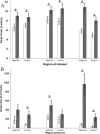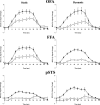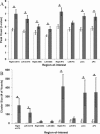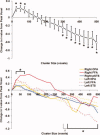Defining the face processing network: optimization of the functional localizer in fMRI
- PMID: 18661501
- PMCID: PMC6870735
- DOI: 10.1002/hbm.20630
Defining the face processing network: optimization of the functional localizer in fMRI
Abstract
Functional localizers that contrast brain signal when viewing faces versus objects are commonly used in functional magnetic resonance imaging studies of face processing. However, current protocols do not reliably show all regions of the core system for face processing in all subjects when conservative statistical thresholds are used, which is problematic in the study of single subjects. Furthermore, arbitrary variations in the applied thresholds are associated with inconsistent estimates of the size of face-selective regions-of-interest (ROIs). We hypothesized that the use of more natural dynamic facial images in localizers might increase the likelihood of identifying face-selective ROIs in individual subjects, and we also investigated the use of a method to derive the statistically optimal ROI cluster size independent of thresholds. We found that dynamic facial stimuli were more effective than static stimuli, identifying 98% (versus 72% for static) of ROIs in the core face processing system and 69% (versus 39% for static) of ROIs in the extended face processing system. We then determined for each core face processing ROI, the cluster size associated with maximum statistical face-selectivity, which on average was approximately 50 mm(3) for the fusiform face area, the occipital face area, and the posterior superior temporal sulcus. We suggest that the combination of (a) more robust face-related activity induced by a dynamic face localizer and (b) a cluster-size determination based on maximum face-selectivity increases both the sensitivity and the specificity of the characterization of face-related ROIs in individual subjects.
(c) 2008 Wiley-Liss, Inc.
Figures








References
-
- Adolphs R,Tranel D,Damasio H,Damasio A ( 1994): Impaired recognition of emotion in facial expressions following bilateral damage to the human amygdala. Nature 372: 669–672. - PubMed
-
- Andrews TJ,Ewbank MP ( 2004): Distinct representations for facial identity and changeable aspects of faces in the human temporal lobe. Neuroimage 23: 905–913. - PubMed
-
- Avidan G,Hasson U,Malach R,Behrmann M ( 2005): Detailed exploration of face‐related processing in congenital prosopagnosia, Part 2: Functional neuroimaging findings. J Cogn Neurosci 17: 1150–1167. - PubMed
-
- Barton JJ ( 2003): Disorders of face perception and recognition. Neurol Clin 21: 521–548. - PubMed
Publication types
MeSH terms
Substances
Grants and funding
LinkOut - more resources
Full Text Sources
Other Literature Sources

